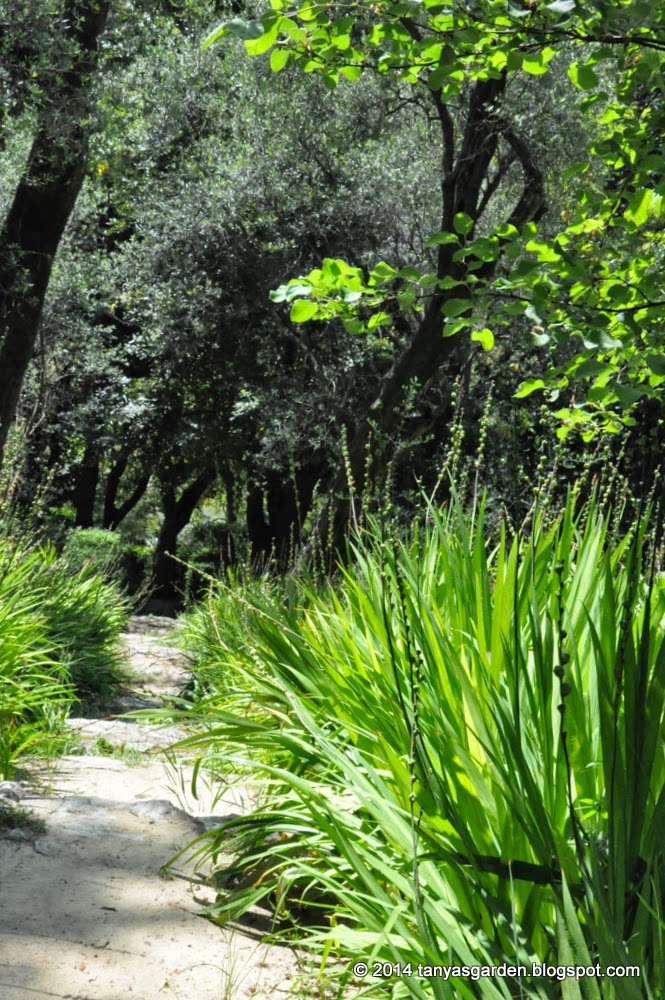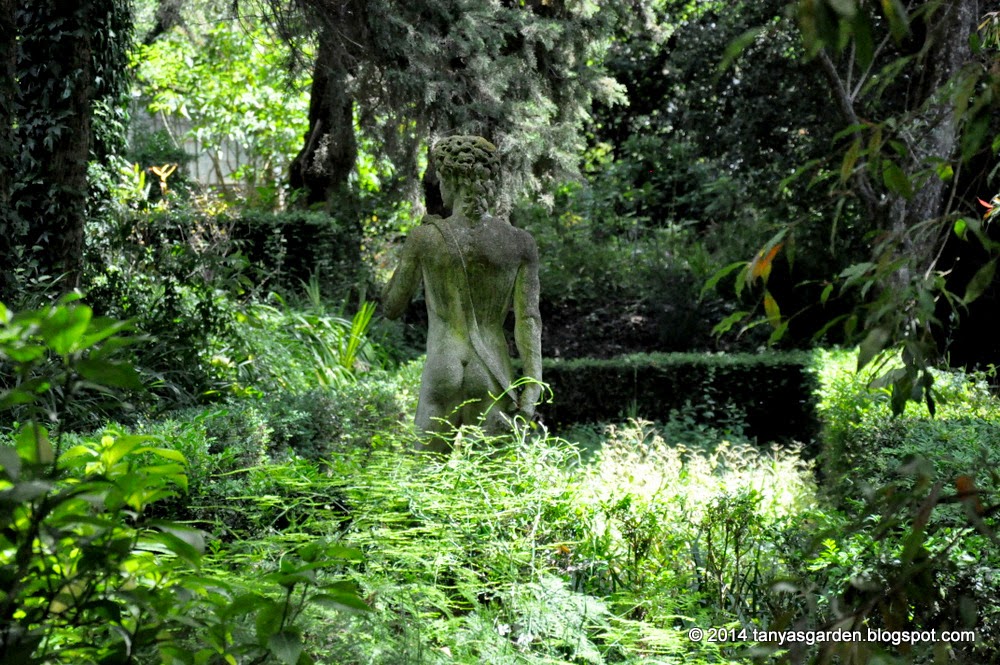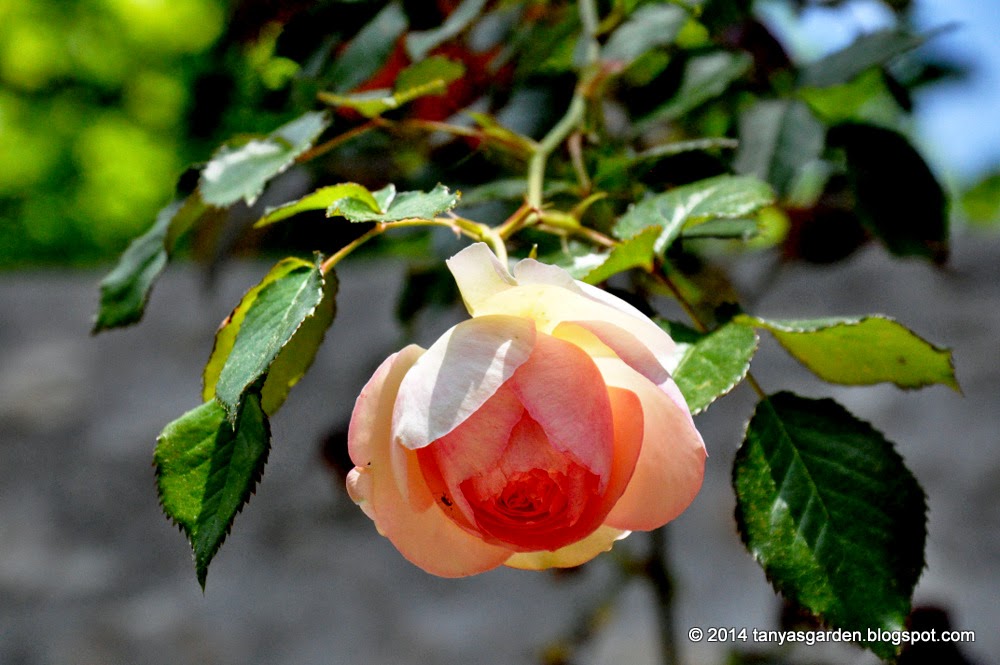This garden on the Mediterranean coast of Southern France was created by Major Lawrence Johnston (1871 - 1958), designer and plantsman, born in London into an American family. I've never been to his garden in England, Hidcote Manor, but visited Serre de la Madone twice: in May 2013 and in May 2014.
Our first visit was wonderful and exciting, but most of the pictures were lost during my camera's battery failure while uploading. To heal the wound, we managed to squeeze a second visit there into our European trip in 2014.
1
2
2013
After his death, Serre de la Madone was held by several owners and eventually was abandoned with plants growing on their own. In 1990, the estate was listed as an Historic monument, and in 1999 was acquired by the French coastal conservation agency, Conservatoire du Littoral. An extensive restoration program was undertaken between 2000 and 2005 mostly by volunteers who were members of the Association for the Preservation and Enhancement of the Serre de la Madone Garden. Botanist Pierre Auge and landscape architects Arnaud Maurieres and Eric Ossart led the effort.
3
4
Hold on now! We have about 200 pictures to see! The day was bright and sunny. I hope you are wearing comfortable shoes and have a bottle of water. Major Johnston chose this site because of its mild micro climate, and it was pretty hot here already in May!
5
Reception building and shop.
This is the former warden's lodge. The curator who runs the shop and sells entrance tickets was very friendly and helpful.
This is the former warden's lodge. The curator who runs the shop and sells entrance tickets was very friendly and helpful.
6
8
There are about 20 green rooms in the garden.
Plant shelter pergola was once fitted with glass and used for acclimatization of plants brought back from Johnston's expeditions.
9
10
12
13
14
15
16
17
18
19
20
21
22
Main pergola
This pergola was planted in the 1930-s with climbers: wisteria, bignonia (cross-vine) and clematis, including Clematis armandii which is now naturalized.
23
24
Bartlettina sordida (Purple torch, Blue mist flower. Mexico)
26
27
29
30
31
32
34
May 2013
35
May 2013
36
May 2013
37
May 2013
38
May 2013
39
May 2013
40
Ceratonia siliqua
41
43
Serre de la Madone has a formal garden which was built following the landscaping fashions of the English-speaking world. It used to have roses bordered by a pathway fringed with box hedges arranged in a maze-like pattern. Nowadays, this area is filled with summer-flowering Frankenia laevis.
4445
46
47
48
49
50
51
52
53
54
55
56
Fabiana imbricata (Pichi. South America)
57
Argyrocytisus battandieri (Moroccan Broom, Pineapple Broom)
58
60
Augustus Caesar pathway
A Roman bust of Caesar is at the end of a shady path fringed with tree peonies (Paeonia suffruticosa).
61
6263
Salvia guaranatica (Brazilian sage)
Brazilian sage, together with honeysuckle and yuccas frame the sides of a service road, wide enough for the gardeners' motorized vehicles. There is a composting area at one end of the road.
64
Former olive grove
66
Ancient olive trees were cultivated here by Johnston. Transformed into a South-African meadow, this space is filled with Chasmanthe bicolor and Amaryllis belladonna. Amaryllis, planted en masse by Johnston, creates a carpet of pink in fall. Chasmanthe was introduced later and produces a mass of orange-red flowers in spring.
These bulbous plants naturalized over time, especially during the years of neglect.
67
68
A statue of David in a small green room planted with summer snowflakes (leucojum aestivum)
69
71
Water garden is shaded by huge umbrella pines. There are two pools here.
This is a rectangular mirror pool reflecting the Provencal sky.
72
73
Smaller square pool hosts lilies, lotus and Egyptian papyrus grass.
Jonston's friends used to call a statue 'Miss Johnston'.
74
75
77
78
79
80
81
8283
84
85
86
Former orangery houses tropical plants, including many creepers, such as Thunbergia grandiflora and coccinea.
87
89
The orangery building is decorated with beautiful finials:
90
9192
This is how the Garden's brochure describes the Dry Garden:
"The terrace overlooking this section planted with cacti and other succulents is interspersed with columns, remnants of a former shaded structure. Worthy of note along this pathway is the Canary strawberry tree (Arbutus canariensis) with its sensuous, deep red bark. Not far from here is the emblematic plant of the garden, the Siam hollygrape (Mahonia siamensis). This shrub, notable for its racemes of sweet-scented yellow flowers which bloom in February, was the first specimen to be brought to Europe and planted here in 1931."
93
Arbutus canariensis
94
95
96
Chondropetalum tectorum
97
99
100
The garden territory is terraced. This gives the opportunity to look back where we came from and see the pools again:
101
Central steps
The flight of steps cuts through many terraces and serves as a central axis of the design.
The upper part of them is now reverted to the original planting theme - species native to the southern hemisphere. Protea family flowers are among them.
103
Protea (Sugarbushes)
104
106
107
108
109
A look back at the former orangery:
110
112
113
114
115
116
117
118
119
120
121
122
123
Main villa reminds of Italian palazzo thanks to its yellow ochre hues and detailed architecture.
The central part, originally a farm, was here when Lawrence Johnston bought it, and two wings by his own design were added later.
During one of our visits, there was a photo exhibition on the first floor of the villa.
The second floor is closed to the public and contains a library, administrative offices and Johnston's original bedroom.
124125
126
Belvedere provides majestic views of the garden, villa and Mont Agel.
127
128
130
131
132
Hispano-Moorish garden is inspired by Johnston's travels.
Its loggia is decorated with azulejos (a form of Spanish and Portuguese painted ceramic tiles),
has an ornamental pond, dovecote and myrtle hedges.
has an ornamental pond, dovecote and myrtle hedges.
This little courtyard used to be a part of an aviary, a huge metal mesh structure covering almost one hectare of woodland. Johnston brought back from his trips ibis, parrots, crowned cranes, golden pheasants and other birds.
133
134
135
Rosa 'Lawrence Johnston'
136
137
138
139140
141
Grevillea 'Winpara'
142
144
Banksia integrifolia
145
145
147
148
149
Callistomon citrinus
150
Cussonia paniculata
152
Now, we are going back down.
Citrus grove is grown on former terraces that were cleared during the restoration.
They used to store the soil that buried the Moorish inspired garden after torrential rains and mudslides of 1952.
Citrus and olive trees are the reminders of the valley's agricultural past.
154
155
Echium candicans (Canary Islands). In May 2013 it was in full bloom!
Looking back at the main villa:
157
158
159
161
162
163
164
Saying bye-bye to David:
165
167
169
170
171
172
173
Passing the main pergola on the way down:
174
May 2013
176
177178
179
Koelreuteria paniculata (China)
180
182
Back to the reception building and shop:
184
186
187
Acanthus mollis
188
I remember how excited I was after seeing Serre de la Madone, especially for the first time in 2013! It was more shady than in May 2014, and I kept telling myself how beautiful shade could be.
I also remember being excited to see familiar plants that grow in my own garden - Acanthus mollis, Tradescantia virginiana, Dierama, Salvias, Campanula, Pelargonium, Ceniranthus, etc. 'They look fabulous en masse' - I told myself. - 'Grow them in groups in your garden!'
I also remember being excited to see familiar plants that grow in my own garden - Acanthus mollis, Tradescantia virginiana, Dierama, Salvias, Campanula, Pelargonium, Ceniranthus, etc. 'They look fabulous en masse' - I told myself. - 'Grow them in groups in your garden!'
The Garden looked natural, non-manicured, unpretentious and yes, under maintained.
Weeds, dry leaves, pieces of bark and flower petals covered the soil, many plants picked up on their own and created large drifts.
Weeds, dry leaves, pieces of bark and flower petals covered the soil, many plants picked up on their own and created large drifts.
It felt like the Garden graciously allowed us to stroll through it and wasn't concerned at all that there were no special preparations made for visitors.
We were almost alone in the Garden during both visits.
I hope to visit Johnston's Hidcote Manor Garden one day as well. I don't expect to be there alone, although...
Address:74 Route de Gorbio, 06500 Menton
Website: www.serredelamadone.com/
***Copyright 2014 TatyanaS http://tanyasgarden.blogspot.com/































































































































































































Tatyana, you showed another wonderful garden, designed by Lawrence Johnston. I know Hidcote, but the pictures of Serra de la Madonne are overwhelming. Love the blue Echiums for instance.
ReplyDeleteThanks Janneke! What was interesting about Echium - our visits were exactly a year apart; it was in full bloom in 2013, but it already finished blooming in 2014. What a difference!
DeleteBeautiful garden, I like this. It's a little wild and plants grow well where they want. I also liked the water garden plants there. Charming were sculptures. There was a lot to look at, but the walk after him was certainly very nice. Regards.
ReplyDeleteGiga, thank you! I liked the sculptures a lot! And there location in the garden is perfect!
DeleteAnother wonderful garden tour, Tatyana. I particularly love the water features, and the sheer 'lushness' of this garden. Thank you. P. x
ReplyDeleteIt's a very good word, lushness, Pam! A bit wild lushness! Thanks!
DeleteThank you for this beautiful " walk " ! Gorgeous garden !
ReplyDeleteI'm glad you like it, Dani! Thanks!
DeleteThank you for sharing this comprehensive tour of a stunning garden! It was featured recently on TV here and great to see it again via your blog :)
ReplyDeleteMark and Gaz, thanks! I think I watched it on Youtube. I liked it.
DeleteStunning garden. Beautiful. Gorgeous pictures. Thanks for going to the trouble to share!
ReplyDeleteKim and Victoria, I hope there are no trouble with so many pictures to view! Thank you!
DeleteThis garden has it all, both plants and architecture and garden rooms. I hope it has a happy present and future and will be cared for.
ReplyDeleteTerra, I also hope it'll get the attention it deserves! Thanks!
DeleteThank you Tatyana! I saw the garden in 1995 when it was still barely touched after the years of neglect. It has - as always - been wonderful to accompany you on a walk around the garden! Jack
ReplyDeleteThank you, Jack! I'd guess the difference is stunning!
DeleteThank you for giving us a personal tour. Very lovely...and all my colors, yellow, orange, red, blue and purple with a splash of white and green all around. Are you dreaming of another trip? It's almost May. Where will you be taking us then?
ReplyDeleteKaren, thank you! Yes, it's your colors! I think 2014 was a record year for us in term of the number of gardens! One day, I should see Hidcote Manor.
DeleteI loved the tour of this bit of paradise! These ancient gardens have so much history and character. It is wonderful that the garden has been restored, and I hope it will bring joy to visitors for many years to come.
ReplyDeleteDeb, I appreciate your words about history and character! Thank you!
DeleteThis is a wonderful garden, and even though it looks a bit ‘wild’ I bet it is a lot of work keeping it looking like this! I have seen Hidcote Manor on TV, a lovely place too. Thanks for letting me tag along :-)
ReplyDeleteHelene, thanks! I think they've done a lot to restore this garden, especially without big funds available!
DeleteTatyana you visit the most stunning gardens and bring their beauty in such amazing images that take my breathe away...thanks for that!
ReplyDeleteThank you Donna for your kind words!
DeleteHello Tatyana girl (glad I had a glass of water with me while touring this amazing garden! haha) ... I so wished I had toured more garden when we lived in the Netherlands .. we did see a pretty botanical garden on the coast of Spain when we stayed there .. sadly graffiti was carved into some of the old cactus type plants, what drives some people to do those type of things is beyond me .. but on the whole it was a wonderful place by the sea.
ReplyDeleteThis garden SO deserved to be rescued and protected .. it does have an informal air about it which endears it even more .. I dislike rigidity ... love the softness and surprises of some of the plants .. the little whole through the stone wall with the mini gates was too cute .. the statuary beautiful ... love seeing some familiar plants ... especially the campanula ... you could take a few days to really view this garden ... a great place to be this morning in our -29 blowing snow morning here in the frozen north !
Thank you !
Joy : )
Hi Joy! It's time to take a couples of weeks and go back to Europe!
DeleteStay warm!
P.S. I saw agave with names carved into its leaves in Italy.... how sad!
Thank you for the wonderful tour of this special, romantic garden
ReplyDeleteThank you Klara!!! I think there are many plants in that garden which are familiar to you!
DeleteThanks for sharing these. I have been to Hidcote, and it was one of the most special places I have ever seen, so it is revealing to see Serre de la Madrone.
ReplyDeleteSigh ... this is all so beautiful, Tatyana, I don't know where to start. It truly looks like heaven on earth to me, especially as my garden outside my window is so cold and barren right now. This is truly the opposite of that. You gave us a very good impression of what the experience would be like to visit this lovely, untamed, yet graceful, regal, sumptious place. Thank you.
ReplyDeleteI would love to see this garden in person. I remember seeing a "Rosemary and Thyme" episode that was filmed there. It is so beautiful.
ReplyDeleteMaravillosas fotografias ... este jardin lo conoci .. porque aparece en el capitulo 1 de la teleserie turca "Gecenin Kralicesi" de Meryem Uzerli y Murat Yildirim y que fue emitido en Chile el año 2016. Saludos desde Santiago de Chile.
ReplyDeleteThank you, Susan!
ReplyDeleteI have just visited in May 2025 - the garden is much the same as you described 10 years ago. I love the wisteria round sitting area at the top of the garden…though would have been better a few weeks ago when flowers were blooming!
ReplyDelete